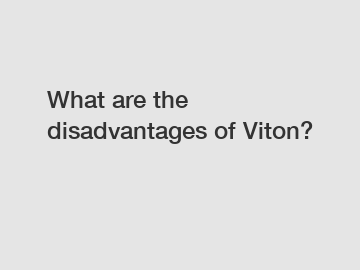What are the disadvantages of Viton?
What are the disadvantages of Viton?
Viton is widely known for its exceptional performance and versatility in various industries. However, like any other material, it has its drawbacks. In this article, we will delve into the disadvantages of Viton, explore the reasons behind these limitations, discuss their significance, and the impact they might have on its usage.
One of the main disadvantages of Viton is its high cost. As a specialized and high-performance material, Viton is more expensive compared to other elastomers. This can significantly impact the overall cost of a project or product, especially when large quantities of Viton are required. The higher cost may discourage some industries or manufacturers from using Viton and push them towards more economical alternatives.

The cost of Viton can be attributed to several factors. Firstly, the raw materials used in the production of Viton, such as fluoropolymers and curing agents, are expensive compared to other elastomers. Additionally, the manufacturing process of Viton involves complex steps and requires specialized equipment, which adds to the overall cost. Furthermore, the limited availability of raw materials and the specialized nature of Viton production can also contribute to its high price.
Despite its high cost, Viton offers exceptional resistance to chemicals, heat, and other harsh environmental conditions. Its ability to withstand extreme temperatures ranging from -40°C to 250°C makes it suitable for a wide range of applications. Viton also exhibits excellent resistance to oils, fuels, acids, and solvents. These unique properties make Viton an ideal choice for industries such as aerospace, automotive, and chemical.
Another disadvantage of Viton is its relatively low resistance to low-temperature flexibility. When exposed to extreme cold temperatures, Viton can become stiff and lose its flexibility, impacting its sealing capabilities. This limitation necessitates careful consideration of the operating environment when selecting Viton as a sealing material.
The low-temperature flexibility issue of Viton is primarily due to its unique composition. Viton contains a high percentage of fluorine, which imparts excellent chemical resistance but reduces its low-temperature performance. To mitigate this limitation, manufacturers have developed formulations with improved low-temperature flexibility, known as Viton GF or Viton Extreme. These modified versions of Viton offer enhanced flexibility at lower temperatures, expanding the range of applications for this elastomer.
In conclusion, despite its exceptional performance characteristics, Viton does have its drawbacks. The high cost of Viton, influenced by expensive raw materials, complex manufacturing processes, and limited availability, can be a deterrent for some industries. Additionally, the relatively low resistance to low-temperature flexibility requires careful consideration during material selection. However, the unique properties of Viton, such as chemical resistance and high-temperature performance, contribute to its widespread usage in various demanding industries. The development of modified versions also addresses some of its limitations and expands its application range.
The company is the world’s best High Abrasion Resistance Nr Rubber Sheet for Sale, Diamond Hammer Top Cow Rubber Mat, Diamond with hammer top cow rubber mat supplier. We are your one-stop shop for all needs. Our staff are highly-specialized and will help you find the product you need.
52
0
0

Comments
All Comments (0)